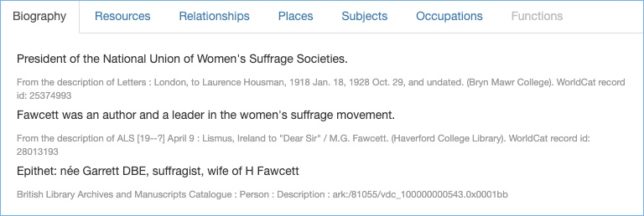It is a somewhat vexed question how to treat biographical and administrative history (in this post I’ll focus on biographical history). This is an ISAD(G) field and an EAD field. ISAD defines it as providing “an administrative history of, or biographical details on, the creator (or creators) of the unit of description to place the material in context and make it better understood”. It advises for personal names to include “full names and titles, dates of birth and death, place of birth, successive places of domicile, activities, occupation or offices, original and any other names, significant accomplishments, and place of death”.
On the Archives Hub we have a whole range of biographical histories – from very short to very comprehensive. I have had conversations with archivists who believe that ‘putting the collection in context’ means giving information that is particularly relevant for that archive rather than giving a general history. Conversely, many biographical history entries do give a very full biography, even if the collection only relates to one aspect of a person’s life and work. They may also include information that is not readily available elsewhere, as it may have been discovered as part of the cataloguing process.
The question is, if we create a generic name record for a person, how do we treat this biographical information? There are a number of alternatives.
(1) Add all biographical history entries to the record
If you look at a SNAC example: https://snaccooperative.org/view/54801840 you can see that this is the approach. It has merits – all of the biographical information is brought together. But it can mean a great deal of repetition, and the ordering of the entries can seem rather illogical, with short entries first and then longer comprehensive entries at the end.
Whilst most biographical history entries are pretty good, it also means a few not very helpful entries may be included, and may be top of the order. In addition, putting all the entries in together doesn’t always seem to make much sense. In the example below there are just three short entries for a major figure in women’s liberation. They are automatically brought in from the catalogue entry for individual collections. Sometimes the biographical entries in individual catalogues suffer from system migration and various data processing issues that mean you end up with field contents that are not ideal.

The question is whether this approach provides a useful and effective end user experience.
Where there is one entry for a creator, with one biographical history, there is no issue other than whether the entry makes sense as an overall biographical entry for that person or organisation. But we have to consider the common situation where there will be a dozen or more entries. Even if we start with one entry, others may be added over time. Generally, there will be repetition and information gaps, but in many cases this approach will provide a good deal of relevant information.
(2) Keep the biographical history entries with the individual name records
At the moment our plan is to create individual name records for each person, as well as a generic master record. We haven’t yet worked out the way this might be presented to the end user. But we could keep the biographical histories with the individual entries we have for names. The generic record would link to these entries, and to the information they contain. This makes sense, as it keeps the biographical histories separate, and within the entries they were written to accompany. Repetition is not an issue as it is clear why that might happen. But the end user has to go to each entry in turn to read this information.
(3) Keep biographical history entries with individual name records, but enable the information to be viewed in the generic master record
We have been thinking about giving the end user the option to ‘click to see all biographical histories created for this person’. That would help with expectations. Simply presenting a page with a dozen similar biographical histories is likely to confuse people, but enabling them to make a decision to view entries gives us more opportunity for explanation – the link could include a brief explanatory note.
(4) Select one biographical history to be in the generic record
We have discussed this idea, but it is really a non-starter. How do you select one entry? What would the criteria be if it is automated? The longest?
(5) Link to a generic biography if available
This is the idea of drawing in the wikipedia entry for that person or organisation, or potentially using another source. There is a certain risk to pulling in data from an external source as the ‘definitive’ biographical information, but it the source would always be cited, and it does start to move towards the principle of bringing different sources of information together. If we want to create a more generic resource, we are going to have to take risks with using external sources.
I would be interested in any comments on this.
